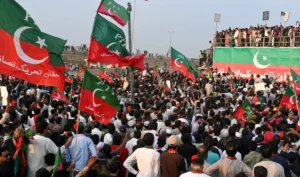Chief Minister KP’s Abduction Deepens Pakistan’s Political Crisis

Unprecedented Detention Sparks Nationwide Controversy
Dramatic Raid and Disappearance
Security forces stormed the Khyber Pakhtunkhwa House in Islamabad under mysterious circumstances. The KP’s Chief Minister, Ali Amin Gandapur, went missing during the raid. Witnesses reported broken doors and ransacked rooms in the aftermath. The state maintains silence about Gandapur’s location and the reasons for his apparent detention.
Mystery Convoy Fuels Speculation
A long convoy of vehicles with tinted windows was seen heading toward Adiala Jail. Official motorcyclists escorted the vehicles, suggesting the movement of a high-profile individual. Sources speculate the convoy transported Gandapur for a meeting with imprisoned former Prime Minister Imran Khan. The timing and security protocol have raised questions about potential political negotiations.
Political Fallout and Power Dynamics
Opposition’s Strong Response
Pakistan Tehreek-e-Insaf leaders issued immediate condemnations of Gandapur’s alleged abduction. Senior leader Asad Qaiser announced plans to convene a tribal jirga to address the crisis. The party frames the incident as a direct attack on provincial autonomy and constitutional rights.
Government Considers Drastic Measures
Federal authorities hint at the possibility of imposing Governor’s Rule in Khyber Pakhtunkhwa. The Interior Minister avoids direct questions, deferring to the President and Prime Minister for decisions. Political analysts view these moves as attempts to destabilize the PTI-led provincial government.
Legal and Constitutional Implications
Constitutional experts warn of severe consequences for Pakistan’s federal structure. The detention of a sitting Chief Minister creates an unprecedented legal crisis. Questions arise about the limits of federal authority over provincial governments.
Public Reaction and Street Protests

Widespread Demonstrations Erupt
PTI supporters gathered in large numbers at Islamabad’s D-Chowk despite heavy police presence. The party mobilized additional supporters from North Punjab and surrounding regions. Protesters faced tear gas and police barriers but maintained their positions.
Regional Support Grows
Party organizations in Balochistan and other provinces pledge solidarity with Khyber Pakhtunkhwa. Reports emerge of spontaneous protests in multiple cities across Pakistan. Social media shows growing public anger over the treatment of elected officials.
Media Coverage Controversy
Some mainstream journalists reported empty protest sites, contradicting video evidence. Social media users share footage of large gatherings, challenging official narratives. The disparity in reporting adds to public skepticism about media independence.
Detention Conditions and Human Rights Concerns
Reports of Mistreatment
Female political workers face particularly harsh treatment during arrests. PTI leader Musarrat Cheema was reportedly detained without proper protocols. Human rights organizations express concern over the treatment of political opponents. Zartaj Gul Wazir, a PTI female MNA was dragged and humiliated to put in her prison van.
Prison Protests Spread
Videos emerge of detained protesters chanting pro-Imran Khan slogans from inside police lockups. The phenomenon indicates growing political consciousness among party workers. Police struggle to contain political activities within detention centers.
Political Negotiations and Power Plays
Pressure Tactics Revealed
Sources suggest authorities use Gandapur’s detention to pressure Imran Khan into ending protests. The government reportedly offers concessions in exchange for calling off demonstrations. The PTI leadership publicly rejects any negotiations under duress.
Opposition Realignment
A pro PML-N political analyst Najam Sethi suggests the government should engage with religious parties. The crisis potentially shifts power dynamics among opposition groups. New political alliances may emerge as the situation evolves.
Impact on Democratic Institutions
Provincial Autonomy Under Threat
The incident sets a dangerous precedent for federal-provincial relations in Pakistan. Constitutional experts warn of long-term damage to democratic norms. The crisis tests the resilience of Pakistan’s federal structure.
Judiciary’s Role
Legal challenges to potential Governor’s Rule are expected in higher courts. The judiciary faces pressure to balance constitutional principles with political realities. The outcome could redefine the relationship between federal and provincial governments.
International Implications
Diplomatic Concerns
The crisis draws international attention to Pakistan’s democratic challenges. Foreign observers express worry about the treatment of opposition politicians. The situation may impact Pakistan’s relationships with democratic allies.
Economic Fallout
Political instability raises concerns about Pakistan’s economic recovery efforts. Investors watch the situation closely for signs of resolution. The crisis adds another layer of uncertainty to Pakistan’s financial outlook.
Looking Ahead: Potential Scenarios
Escalation Risks
The standoff shows no signs of immediate resolution. Both sides appear prepared for a prolonged confrontation. The potential for further escalation remains high as tensions mount.
Calls for Dialogue
Moderate voices urge both sides to engage in meaningful dialogue. Some leaders propose third-party mediation to resolve the crisis. The path to de-escalation remains unclear amid hardening positions.
Public Sentiment and National Unity
Growing Polarization
The crisis deepens existing political divisions in Pakistani society. Some view the situation as a struggle for democratic survival. Others see it as necessary to maintain law and order.
Grassroots Movement
Young people increasingly engage in political activism despite risks. Social media amplifies voices of dissent across the country. The crisis transforms from a political dispute into a broader social movement.
Conclusion: A Nation at Crossroads
Pakistan faces a critical moment in its democratic journey. The resolution of this crisis may define the country’s political future. As tensions persist, the need for constitutional solutions becomes increasingly urgent.
